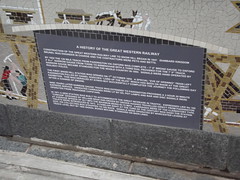Commemorated on 1 plaque
A History of the Great Western Railway Construction of the Great Western Railway line to Snow Hill began in 1847. Isambard Kingdom Brunel was engineer in charge and the contractors were Peto and Betts. By 1852 the 129 mile track from Paddington via Oxford was complete - 7' 0" broad gauge to Oxford 4' 8½" narrow gauge from there to Birmingham with a third rail provided for the 7' 0" track. Narrow gauge became standard for the whole country in 1892. Signals were hand operated by railway police. The first Snow Hill station was opened on 1st October 1852. A special "Eve of Opening" train left Paddington pulled by Daniel Gooches "Lord of the Isles" which had been on show at the Great Exhibition. This was derailed at Aynho but successfully completed the journey the following day after a change in engine. Nine years later narrow gauge track was extended to Paddington providing a 3 hour 20 minute express service. Unheated carriages were lit by oil pot lamps and bar and disc signals were operated from trackside capstans. In 1871 a new station was built to accommodate the great increase in traffic. Expresses like No 162 "Cobham" designed by William Dean and driven by driver Hughes travelled direct from Paddington at average speeds of 52.7 MPH the maximum being 62.75 MPH. Carriages were of the clerestory type. Toilets were introduced in 1873. A familiar sight at the turn of the century was Dash the station dog. His collecting box strapped to his back. Signals were operated by Worcester levers at track level but by 1900 signal boxes became standard on main lines.
Birmingham Snow Hill Station - behind 1 Colmore Row, Birmingham, United Kingdom where they built (1847-1852)
